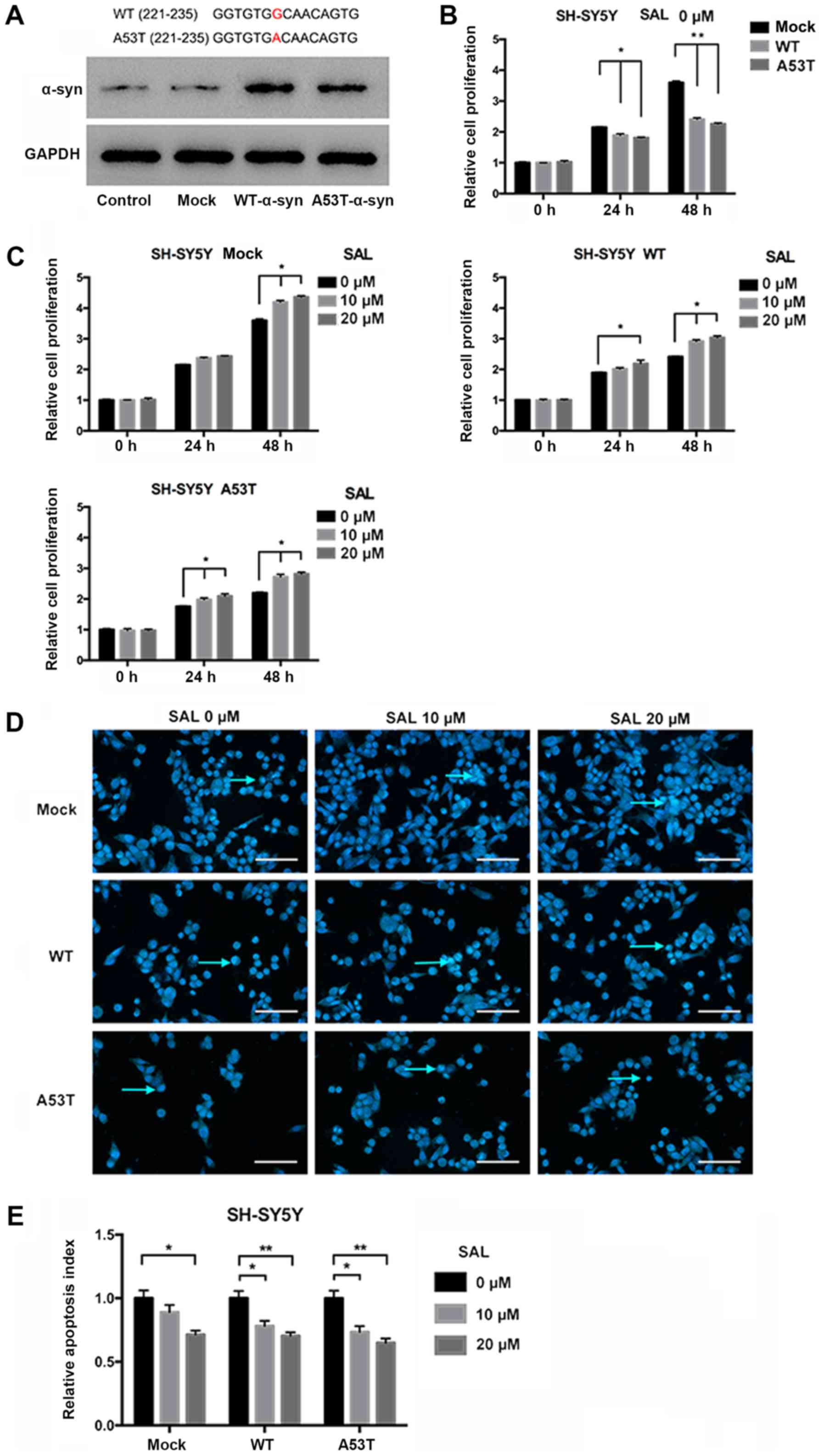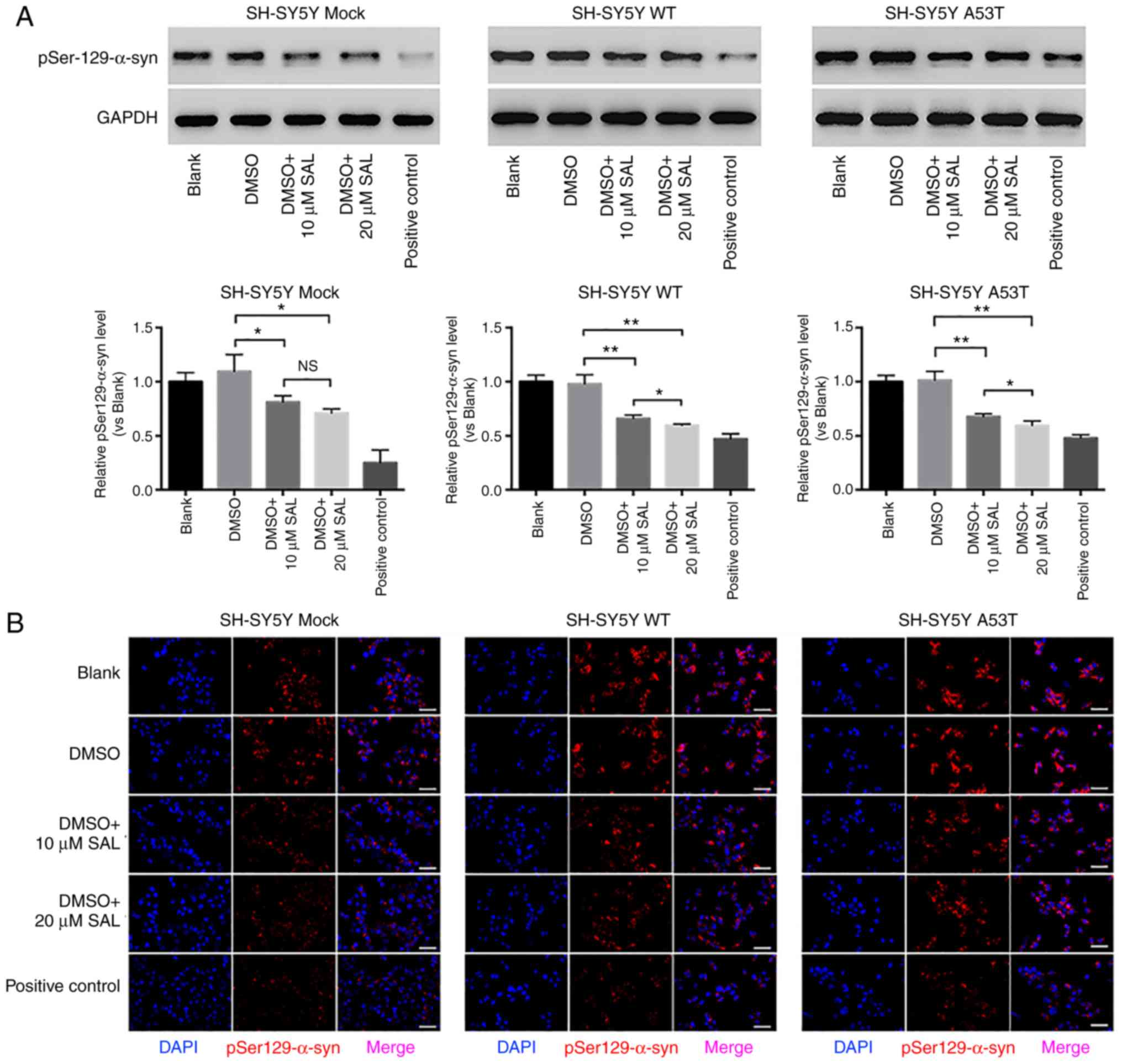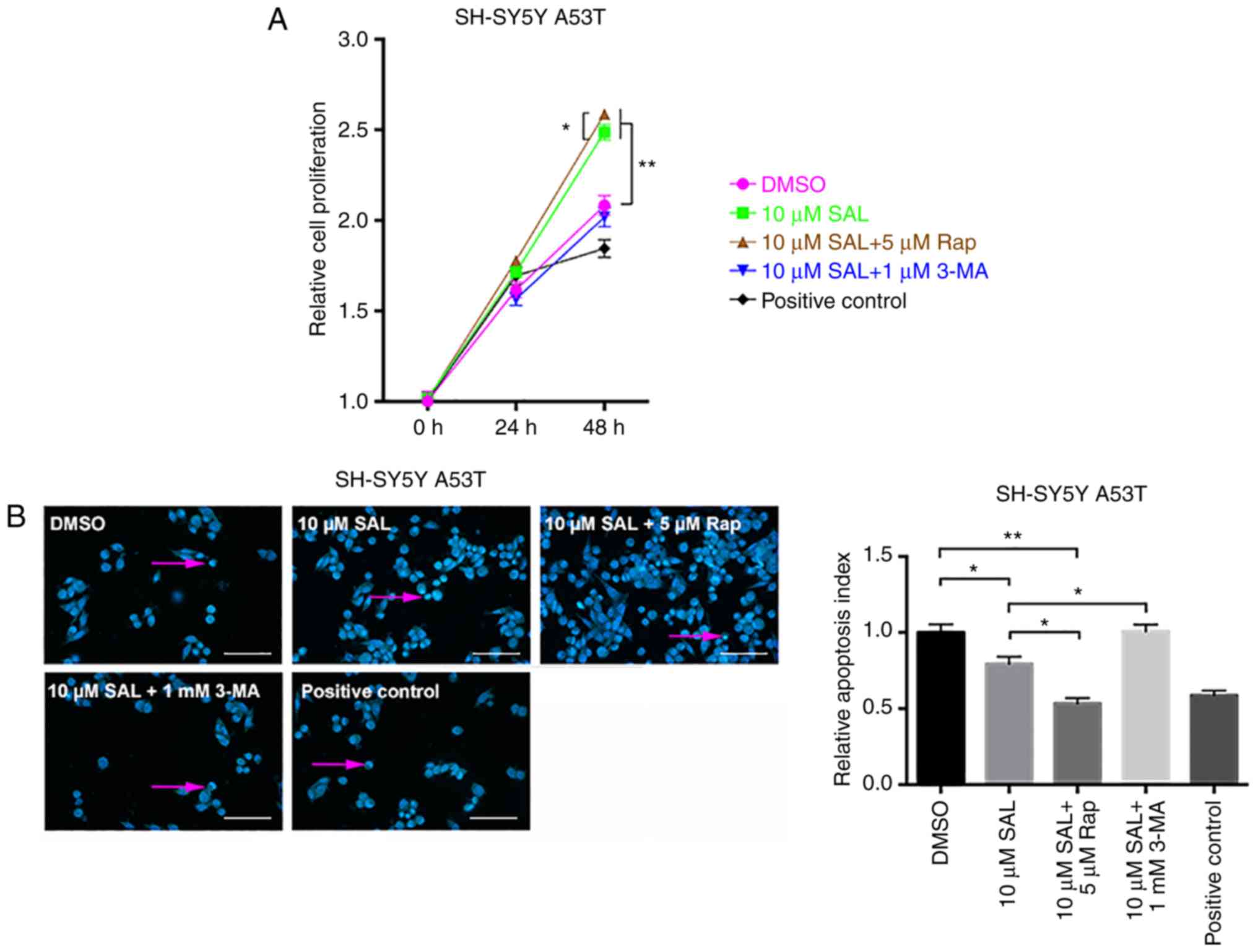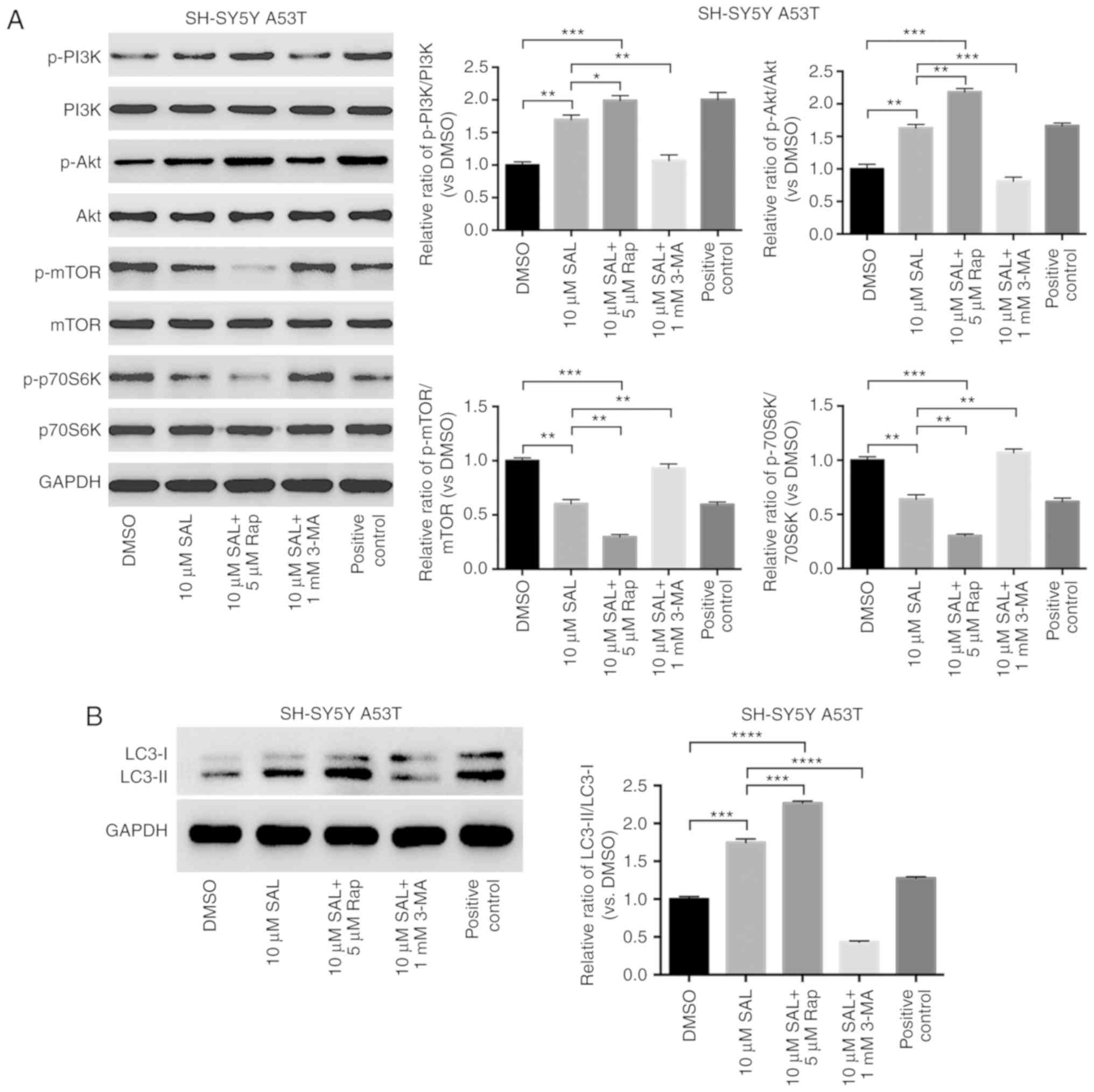|
1
|
Jenner P, Morris HR, Robbins TW, Goedert
M, Hardy J, Ben-Shlomo Y, Bolam P, Burn D, Hindle JV and Brooks D:
Parkinson's disease-the debate on the clinical phenomenology,
aetiology, pathology and pathogenesis. J Parkinsons Dis. 3:1–11.
2013.PubMed/NCBI
|
|
2
|
Spillantini MG, Schmidt ML, Lee VM,
Trojanowski JQ, Jakes R and Goedert M: Alpha-synuclein in Lewy
bodies. Nature. 388:839–840. 1997. View
Article : Google Scholar : PubMed/NCBI
|
|
3
|
Jakes R, Spillantini MG and Goedert M:
Identification of two distinct synucleins from human brain. FEBS
Lett. 345:27–32. 1994. View Article : Google Scholar : PubMed/NCBI
|
|
4
|
Alves da Costa C, Dunys J, Brau F, Wilk S,
Cappai R and Checler F: 6-Hydroxydopamine but not
1-methyl-4-phenylpyridinium abolishes alpha-synuclein
anti-apoptotic phenotype by inhibiting its proteasomal degradation
and by promoting its aggregation. J Biol Chem. 281:9824–9831. 2006.
View Article : Google Scholar : PubMed/NCBI
|
|
5
|
Del Tredici K and Braak H: Review:
Sporadic Parkinson's disease: Development and distribution of
alpha-synuclein pathology. Neuropathol Appl Neurobiol. 42:33–50.
2016. View Article : Google Scholar : PubMed/NCBI
|
|
6
|
Volpicelli-Daley LA, Luk KC, Patel TP,
Tanik SA, Riddle DM, Stieber A, Meaney DF, Trojanowski JQ and Lee
VM: Exogenous α-synuclein fibrils induce Lewy body pathology
leading to synaptic dysfunction and neuron death. Neuron. 72:57–71.
2011. View Article : Google Scholar : PubMed/NCBI
|
|
7
|
Desplats P, Lee HJ, Bae EJ, Patrick C,
Rockenstein E, Crews L, Spencer B, Masliah E and Lee SJ: Inclusion
formation and neuronal cell death through neuron-to-neuron
transmission of alpha-synuclein. Proc Natl Acad Sci USA.
106:13010–13015. 2009. View Article : Google Scholar : PubMed/NCBI
|
|
8
|
Hansen C, Angot E, Bergstrom AL, Steiner
JA, Pieri L, Paul G, Outeiro TF, Melki R, Kallunki P, Fog K, et al:
α-Synuclein propagates from mouse brain to grafted dopaminergic
neurons and seeds aggregation in cultured human cells. J Clin
Invest. 121:715–725. 2011. View
Article : Google Scholar : PubMed/NCBI
|
|
9
|
Luk KC, Kehm V, Carroll J, Zhang B,
O'Brien P, Trojanowski JQ and Lee VM: Pathological alpha-synuclein
transmission initiates Parkinson-like neurodegeneration in
nontransgenic mice. Science. 338:949–953. 2012. View Article : Google Scholar : PubMed/NCBI
|
|
10
|
Mougenot AL, Nicot S, Bencsik A, Morignat
E, Verchère J, Lakhdar L, Legastelois S and Baron T: Prion-like
acceleration of a synucleinopathy in a transgenic mouse model.
Neurobiol Aging. 33:2225–2228. 2012. View Article : Google Scholar : PubMed/NCBI
|
|
11
|
Tyedmers J, Mogk A and Bukau B: Cellular
strategies for controlling protein aggregation. Nat Rev Mol Cell
Biol. 11:777–788. 2010. View
Article : Google Scholar : PubMed/NCBI
|
|
12
|
Danzer KM, Kranich LR, Ruf WP,
Cagsal-Getkin O, Winslow AR, Zhu L, Vanderburg CR and McLean PJ:
Exosomal cell-to-cell transmission of alpha synuclein oligomers.
Mol Neurodegener. 7:422012. View Article : Google Scholar : PubMed/NCBI
|
|
13
|
Tanik SA, Schultheiss CE, Volpicelli-Daley
LA, Brunden KR and Lee VM: Lewy body-like alpha-synuclein
aggregates resist degradation and impair macroautophagy. J Biol
Chem. 288:15194–15210. 2013. View Article : Google Scholar : PubMed/NCBI
|
|
14
|
Grech-Baran M, Syklowska-Baranek K and
Pietrosiuk A: Biotechnological approaches to enhance salidroside,
rosin and its derivatives production in selected Rhodiola spp. in
vitro cultures. Phytochem Rev. 14:657–674. 2015. View Article : Google Scholar : PubMed/NCBI
|
|
15
|
Mao GX, Wang Y, Qiu Q, Deng HB, Yuan LG,
Li RG, Song DQ, Li YY, Li DD and Wang Z: Salidroside protects human
fibroblast cells from premature senescence induced by H(2)O(2)
partly through modulating oxidative status. Mech Ageing Dev.
131:723–731. 2010. View Article : Google Scholar : PubMed/NCBI
|
|
16
|
Li X, Ye X, Li X, Sun X, Liang Q, Tao L,
Kang X and Chen J: Salidroside protects against MPP(+)-induced
apoptosis in PC12 cells by inhibiting the NO pathway. Brain Res.
1382:9–18. 2011. View Article : Google Scholar : PubMed/NCBI
|
|
17
|
Zhang L, Yu H, Zhao X, Lin X, Tan C, Cao G
and Wang Z: Neuroprotective effects of salidroside against
beta-amyloid-induced oxidative stress in SH-SY5Y human
neuroblastoma cells. Neurochem Int. 57:547–555. 2010. View Article : Google Scholar : PubMed/NCBI
|
|
18
|
Zhu Y, Shi YP, Wu D, Ji YJ, Wang X, Chen
HL, Wu SS, Huang DJ and Jiang W: Salidroside protects against
hydrogen peroxide-induced injury in cardiac H9c2 cells via PI3K-Akt
dependent pathway. DNA Cell Biol. 30:809–819. 2011. View Article : Google Scholar : PubMed/NCBI
|
|
19
|
Chojnacki S, Cowley A, Lee J, Foix A and
Lopez R: Programmatic access to bioinformatics tools from EMBL-EBI
update: 2017. Nucleic Acids Res. 45:W550–W553. 2017. View Article : Google Scholar : PubMed/NCBI
|
|
20
|
Mohan N, Banik NL and Ray SK: Combination
of N-(4-hydroxyphenyl) retinamide and apigenin suppressed
starvation-induced autophagy and promoted apoptosis in malignant
neuroblastoma cells. Neurosci Lett. 502:24–29. 2011. View Article : Google Scholar : PubMed/NCBI
|
|
21
|
Schaaf MB, Keulers TG, Vooijs MA and
Rouschop KM: LC3/GABARAP family proteins: Autophagy-(un)related
functions. FASEB J. 30:3961–3978. 2016. View Article : Google Scholar : PubMed/NCBI
|
|
22
|
Lashuel HA, Overk CR, Oueslati A and
Masliah E: The many faces of alpha-synuclein: From structure and
toxicity to therapeutic target. Nat Rev Neurosci. 14:38–48. 2013.
View Article : Google Scholar : PubMed/NCBI
|
|
23
|
Chu Y and Kordower JH: Age-associated
increases of alpha-synuclein in monkeys and humans are associated
with nigrostriatal dopamine depletion: Is this the target for
Parkinson's disease? Neurobiol Dis. 25:134–149. 2007. View Article : Google Scholar : PubMed/NCBI
|
|
24
|
Lee VM, Giasson BI and Trojanowski JQ:
More than just two peas in a pod: Common amyloidogenic properties
of tau and alpha-synuclein in neurodegenerative diseases. Trends
Neurosci. 27:129–134. 2004. View Article : Google Scholar : PubMed/NCBI
|
|
25
|
Barrett PJ and Timothy Greenamyre J:
Post-translational modification of alpha-synuclein in Parkinson's
disease. Brain Res. 1628:247–253. 2015. View Article : Google Scholar : PubMed/NCBI
|
|
26
|
Fujiwara H, Hasegawa M, Dohmae N,
Kawashima A, Masliah E, Goldberg MS, Shen J, Takio K and Iwatsubo
T: Alpha-Synuclein is phosphorylated in synucleinopathy lesions.
Nat Cell Biol. 4:160–164. 2002. View
Article : Google Scholar : PubMed/NCBI
|
|
27
|
Smith WW, Margolis RL, Li X, Troncoso JC,
Lee MK, Dawson VL, Dawson TM, Iwatsubo T and Ross CA:
Alpha-synuclein phosphorylation enhances eosinophilic cytoplasmic
inclusion formation in SH-SY5Y cells. J Neurosci. 25:5544–5552.
2005. View Article : Google Scholar : PubMed/NCBI
|
|
28
|
Schell H, Hasegawa T, Neumann M and Kahle
PJ: Nuclear and neuritic distribution of serine-129 phosphorylated
alpha- synuclein in transgenic mice. Neuroscience. 160:796–804.
2009. View Article : Google Scholar : PubMed/NCBI
|
|
29
|
Zhou J, Broe M, Huang Y, Anderson JP, Gai
WP, Milward EA, Porritt M, Howells D, Hughes AJ, Wang X and
Halliday GM: Changes in the solubility and phosphorylation of
α-synuclein over the course of Parkinson's disease. Acta
Neuropathol. 121:695–704. 2011. View Article : Google Scholar : PubMed/NCBI
|
|
30
|
Rubinsztein DC, Gestwicki JE, Murphy LO
and Klionsky DJ: Potential therapeutic applications of autophagy.
Nat Rev Drug Discov. 6:304–312. 2007. View
Article : Google Scholar : PubMed/NCBI
|
|
31
|
Bennett MC, Bishop JF, Leng Y, Chock PB,
Chase TN and Mouradian MM: Degradation of alpha-synuclein by
proteasome. J Biol Chem. 274:33855–33858. 1999. View Article : Google Scholar : PubMed/NCBI
|
|
32
|
Cuervo AM, Stefanis L, Fredenburg R,
Lansbury PT and Sulzer D: Impaired degradation of mutant
alpha-synuclein by chaperone-mediated autophagy. Science.
305:1292–1295. 2004. View Article : Google Scholar : PubMed/NCBI
|
|
33
|
Winslow AR, Chen CW, Corrochano S,
Acevedo-Arozena A, Gordon DE, Peden AA, Lichtenberg M, Menzies FM,
Ravikumar B, Imarisio S, et al: α-Synuclein impairs macroautophagy:
Implications for Parkinson's disease. J Cell Biol. 190:1023–1037.
2010. View Article : Google Scholar : PubMed/NCBI
|
|
34
|
Panossian A, Wikman G and Sarris J:
Rosenroot (Rhodiola rosea): Traditional use, chemical composition,
pharmacology and clinical efficacy. Phytomedicine. 17:481–493.
2010. View Article : Google Scholar : PubMed/NCBI
|
|
35
|
Zhong Z, Han J, Zhang J, Xiao Q, Hu J and
Chen L: Pharmacological activities, mechanisms of action, and
safety of salidroside in the central nervous system. Drug Des Devel
Ther. 12:1479–1489. 2018. View Article : Google Scholar : PubMed/NCBI
|
|
36
|
Wang S, He H, Chen L, Zhang W, Zhang X and
Chen J: Protective effects of salidroside in the
MPTP/MPP(+)-induced model of Parkinson's disease through
ROS-NO-related mitochondrion pathway. Mol Neurobiol. 51:718–728.
2015. View Article : Google Scholar : PubMed/NCBI
|
|
37
|
Zhang L, Ding W, Sun H, Zhou Q, Huang J,
Li X, Xie Y and Chen J: Salidroside protects PC12 cells from
MPP+-induced apoptosis via activation of the PI3K/Akt
pathway. Food Chem Toxicol. 50:2591–2597. 2012. View Article : Google Scholar : PubMed/NCBI
|
|
38
|
Parihar MS, Parihar A, Fujita M, Hashimoto
M and Ghafourifar P: Alpha-synuclein overexpression and aggregation
exacerbates impairment of mitochondrial functions by augmenting
oxidative stress in human neuroblastoma cells. Int J Biochem Cell
Biol. 41:2015–2024. 2009. View Article : Google Scholar : PubMed/NCBI
|
|
39
|
Tsang AH and Chung KK: Oxidative and
nitrosative stress in parkinson's disease. Biochim Biophys Acta.
1792:643–650. 2009. View Article : Google Scholar : PubMed/NCBI
|
|
40
|
Heras-Sandoval D, Perez-Rojas JM,
Hernandez-Damian J and Pedraza-Chaverri J: The role of
PI3K/AKT/mTOR pathway in the modulation of autophagy and the
clearance of protein aggregates in neurodegeneration. Cell Signal.
26:2694–2701. 2014. View Article : Google Scholar : PubMed/NCBI
|
|
41
|
Kocaturk NM and Gozuacik D: Crosstalk
between mammalian autophagy and the ubiquitin-proteasome system.
Front Cell Dev Biol. 6:1282018. View Article : Google Scholar : PubMed/NCBI
|
|
42
|
Li T, Feng Y, Yang R, Wu L, Li R, Huang L,
Yang Q and Chen J: Salidroside promotes the pathological
alpha-synuclein clearance through ubiquitin-proteasome system in
SH-SY5Y Cells. Front Pharmacol. 9:3772018. View Article : Google Scholar : PubMed/NCBI
|













